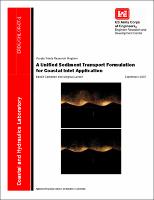Please use this identifier to cite or link to this item:
https://hdl.handle.net/11681/1807| Title: | A unified sediment transport formulation for coastal inlet application |
| Authors: | Camenen, Benoit Larson, Magnus |
| Keywords: | Bed load transport Coastal sediment transport Phase lag Sheet flow Suspended load transport Transport by current and waves Coastal Inlets Research Program (U.S.) |
| Publisher: | Engineer Research and Development Center (U.S.) |
| Series/Report no.: | Contract report (Engineer Research and Development Center (U.S.)) ; no.ERDC/CHL CR-07-1 |
| Abstract: | The Coastal Inlets Research Program (CIRP) is developing predictive numerical models for simulating the waves, currents, sediment transport, and morphology change at and around coastal inlets. Water motion at a coastal inlet is a combination of quasi-steady currents such as river flow, tidal current, wind-generated current, and seiching, and of oscillatory flows generated by surface waves. Waves can also create quasi-steady currents, and the waves can be breaking or non-breaking, greatly changing potential for sediment transport. These flows act in arbitrary combinations with different magnitudes and directions to mobilize and transport sediment. Reliable prediction of morphology change requires accurate predictive formulas for sediment transport rates that smoothly match in the various regimes of water motion. This report describes results of a research effort conducted to develop unified sediment transport rate predictive formulas for application in the coastal inlet environment. The formulas were calibrated with a wide range of available measurements compiled from the laboratory and field and then implemented in the CIRP’s Coastal Modeling System. Emphasis of the study was on reliable predictions over a wide range of input conditions. All relevant physical processes were incorporated to obtain greatest generality, including: (1) bed load and suspended load, (2) waves and currents, (3) breaking and non-breaking waves, (4) bottom slope, (5) initiation of motion, (6) asymmetric wave velocity, and (7) arbitrary angle between waves and current. A large database on sediment transport measurements made in the laboratory and the field was compiled to test different aspects of the formulation over the widest possible range of conditions. Other phenomena or mechanisms may also be of importance, such as the phase lag between water and sediment motion or the influence of bed forms. Modifications to the general formulation are derived to take these phenomena into account. The performance of the new transport formulation was compared to several popular existing predictive formulas, and the new formulation yielded the overall best predictions among the formulas investigated. Results of this report are thus considered to represent a significant and operational step toward a unified formulation for sediment transport at coastal inlets and the nearshore where transport of non-cohesive sediment is common. |
| Description: | Contract Report |
| Gov't Doc #: | ERDC/CHL CR-07-1 |
| Rights: | Approved for public release; distribution is unlimited |
| URI: | http://hdl.handle.net/11681/1807 |
| Appears in Collections: | Contract Report Contract Report |
Files in This Item:
| File | Description | Size | Format | |
|---|---|---|---|---|
| ERDC-CHL-CR-07-1.pdf | ERDC/CHL CR-07-1 | 13.64 MB | Adobe PDF |  View/Open |